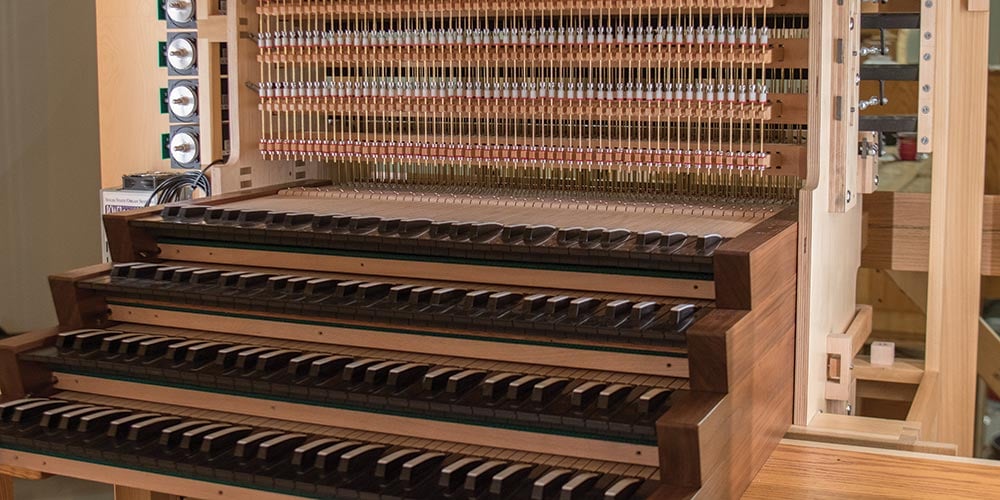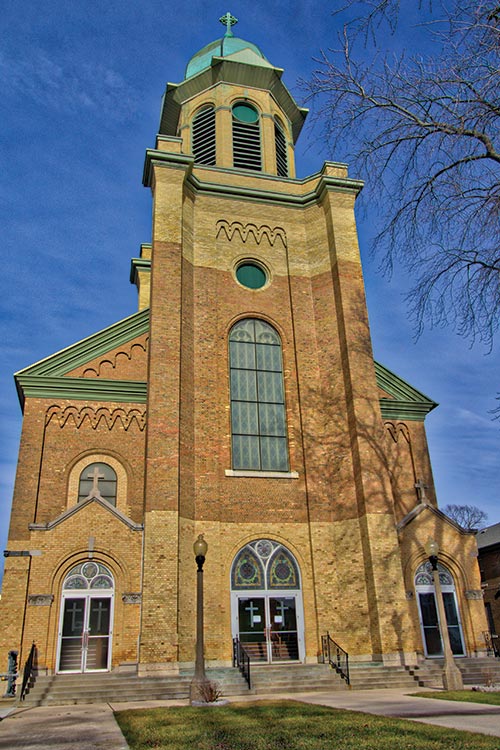
Thinking outside the “evangelism box” isn’t the typical perception people have of classical musicians. But when it comes to Arpad Muranyi, we may need to alter our views.
His quest began simply enough. A musician and engineer originally from Hungary who now resides in Wisconsin, Muranyi wanted to own a pipe organ. Not just any pipe organ, but one of such high quality and majestic sound that it would thrill the soul of anyone who heard it, or any skilled organist who sat down at its keyboards. What he ended up with is not only such an instrument but also a former Catholic church and school, an Adventist congregation that now meets each Sabbath in his “living room,” and a local outreach that is touching hearts in the community.

Muranyi was exposed to organ music even before he was born. His mother, while pregnant, would often listen to her musician husband practice the organ.
“I’ve loved organ music all my life,” he says.
Muranyi’s father, however, didn’t encourage him to pursue a career as an organist, saying he didn’t think it would provide a good living.
“In Hungary during those Communist years the churches were poor, and the Communist system was not very supportive of church organists,” Muranyi explains. “So I got my professional music training in cello playing. But I still love the organ and have played it in church since I was 11.”
Muranyi also became curious about how organs work, and was frequently found climbing inside them and “fixing things.” The more he learned, the more he became interested in organ building and pursuing a career in engineering.
His dad insisted, though, that he first complete his cello training—which he did. After graduating from the Franz Liszt Academy of Music in Budapest, Hungary, Muranyi received a scholarship for the prestigious Moscow Tchaikovsky Conservatory. After studying there for a year, he came to the United States on a scholarship to continue his musical studies. In 1989, when Muranyi was 31, he obtained a position with the Sacramento Symphony Orchestra in California. It was then he changed directions.
“I decided to enroll in engineering school,” he says. “I landed an internship with Intel Corporation in Folsom. When I finished my education in engineering, Intel hired me full-time. I loved what I was doing there and worked in Folsom for 17 years. During all that time I continued organ playing and choral conducting, but not on a professional level.”
Then a desire to have his own pipe organ began to develop.
In the late 1980s and early 1990s digital technology in electronic organs significantly improved their quality and sound, but “electronic speakers will never be able to reproduce the sound of a pipe organ and the acoustics of a cathedral perfectly,” Muranyi says. “My desire was to have my own pipe organ.”
At first his plan was to buy a small pipe organ that would fit into the living room of his California home. But an architect looked at Muranyi as if he were crazy, Muranyi says, and quoted him a price tag he considered “outrageous and unaffordable.” A friend then suggested he check out churches for sale.

“I started to shop around, and I found this church in Fond du Lac, Wisconsin, which was in relatively good condition. It was just right for what I was looking for in an acoustical sense for music purposes. It actually had an organ in it already, but the organ wasn’t what I wanted in terms of size and quality. I ended up buying the church complex in 2007.”
The “complex” consisted of not only a church that seats more than 500 people but also a school with a gym, and two houses that formerly served as a convent and a rectory. Muranyi and his wife, Estie, and their son, Andras, age 15, set up housekeeping in rooms of the church, using the kitchen adjoining the church and school to prepare the family meals.
Soon after, Muranyi found and purchased a Casavant Opus 3364 pipe organ (built in 1978) from a church in Princeton, New Jersey, and began the process of disassembling it, moving it to Fond du Lac, and putting it back together, with some modifications. The first phase of the process took several years to complete. While all this was happening, however, the Muranyi family didn’t let the property remain idle.
In Fond du Lac small Adventist groups had been meeting and worshipping together off and on for some years. Then about 2005, following a Wisconsin Conference evangelistic thrust in the area, a branch Sabbath School of about 10 members began to develop into a more established presence. They first met in community buildings and various group members’ homes, then later rented a small conference room at the local fairground. But after Muranyi purchased the church in Fond du Lac and learned of the Adventist group, he thought, Why can’t they meet here?
So the families began holding Sabbath worship services at the church, and their number has grown.
“This was like an answer to prayer,” says Le Suong Cina, whose family, together with two other families, was part of the core group that has now blossomed into a solid and consistent presence of Adventist believers in Fond du Lac. “We no longer needed to hunt for a place to gather every Sabbath; it gave us stability. It’s also a landmark location, so it is visible and well known, giving the Adventists an obvious presence in the community. The location is in a populated and central part of the city, which aids in outreach. The potential for growth and networking is great, and there has been continued growth in numbers as well as activity within the church and in the community.”
“It was just a natural continuum to bring the people here to meet,” Muranyi says. “I joke sometimes about it, that the members of the congregation are our guests every Sabbath. The church building could basically be considered our living room, and the group that comes here to worship are our guests every Sabbath.”

The church group, now comprising about 32 members, is active with community outreach and giving Bible studies. The church building, with its good acoustics and high-quality pipe organ, is also a compelling draw to those in the community who love music.
“We have concerts here,” Muranyi explains. “I also rent out the church to groups for classical musical performances. When a choir performs, sometimes there are 300 to 400 people in the audience. I’ve been told that some people come to the concerts because they want to see their former church again. They have an emotional attachment to the place.
“The choral director of the former Catholic parish comes to many of the concerts as well, and he pointed out to me that some of the people who used to be members of the parish sit in the same exact spots during the concerts as when they attended Mass here. They come back and sit in the same place every time.”
He adds, “It’s a family church for them.”
Describing the music world as relatively small, Muranyi says performers and concert organizers have learned about the church being used for concerts by word of mouth. There are musicians who are looking for a place to do recitals, and chamber music groups are drawn by the good acoustics.
“We had a 110-member choir perform a Christmas concert here in 2012,” Muranyi says.
Recently retired Wisconsin Conference president Don Corkum jokingly says that when he and others prayed for a facility in which the Adventist group in Fond du Lac could meet, God provided a cathedral! And they’re grateful He did.
“Arpad and his family are very gifted people, and they’ve used music as an entering wedge in the community,” Corkum says. “We often think of health outreach in this way; Arpad thinks of music.”
Corkum, who has attended some of the concerts and initial Adventist group meetings at the Fond du Lac church, remembers the former Catholic pastor of the church coming to the concerts, and says that the community people identify with the church and are grateful that it’s still being used for worship.
“This is a great story of how God has put together a person’s need for music and a pipe organ with the need of an Adventist church for a facility and an opportunity to reach out to the community. It’s unique,” Corkum says. “It seems that all these things have come together to celebrate and to make an impact for God.”
Samuel Garbi, a former pastor in the district, also credits the Muranyi family with playing a large role in the growth and establishment of the Fond du Lac church group.
“Arpad’s passion for quality music and the organ, coupled with his and his wife, Estie’s, commitment to pouring all their family resources into evangelistic involvement in the community, were a major force that enabled the Fond du Lac church group to officially acquire company status in the Wisconsin Conference,” Garbi says.
Garbi was a professional violinist before entering the pastoral ministry, and studied at the National Conservatory of Music in Paris, France, as well as at the Rubin Academy of Music in Jerusalem, Israel, so he was particularly impressed with Muranyi’s musical and evangelistic focus.
“[The Muranyis] contributed a permanent home for the church, quality church programs, delicious potlucks, and leadership,” he says. “It was delightful for me to get acquainted with these fellow Europeans and to play music with Arpad.”
The two houses on the complex are currently being renovated; the Muranyi family plans to eventually move into one of them. A local Baptist church rents the school building.
“I have to have rentals or I wouldn’t be able to afford all this,” says Muranyi, who is personally footing the bill for the project.
So has it all been worth it? Muranyi says “Yes!”
“While moving to Fond du Lac and working on this project presented numerous challenges and unforeseen difficulties, we feel that God gives us many opportunities to meet and reach out to people whom we would have otherwise never met,” Muranyi says. “Music is a very powerful tool for reaching the souls of people. We pray and hope that God will use us for His purpose in all we do here.”
Sandra Blackmer is an assistant editor for Adventist Review.